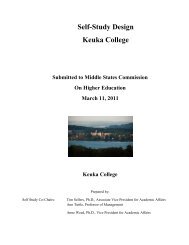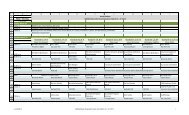final version of the self-study document - Keuka College's Middle ...
final version of the self-study document - Keuka College's Middle ...
final version of the self-study document - Keuka College's Middle ...
You also want an ePaper? Increase the reach of your titles
YUMPU automatically turns print PDFs into web optimized ePapers that Google loves.
2. “Coursework emphasized: syn<strong>the</strong>sizing and organizing ideas, information, or<br />
experiences into new more complex interpretations and relationships (83.5%);<br />
3.“Coursework emphasized: making judgments about <strong>the</strong> value <strong>of</strong> information,<br />
arguments, or methods, such as examining how o<strong>the</strong>rs ga<strong>the</strong>red and interpreted data and<br />
assessing <strong>the</strong> soundness <strong>of</strong> conclusions” (83%);<br />
4. “Coursework emphasized: applying <strong>the</strong>ories or concepts to practical problems or in<br />
new situations” (85%).<br />
These responses suggest that students believed <strong>the</strong>ir education at <strong>Keuka</strong> College focused mainly<br />
on <strong>the</strong> higher levels <strong>of</strong> learning that indicate course rigor.<br />
To ensure adequate content and rigor, <strong>the</strong> <strong>Keuka</strong> College Essential Learning Outcomes<br />
definitions (Appendix 4.16 ELEAP definitions) provide an overall foundation for supporting this<br />
purpose. Not only is <strong>the</strong>re evidence <strong>of</strong> a broad approach to student education, but <strong>the</strong> appearance<br />
<strong>of</strong> such terms as “creativity,” “syn<strong>the</strong>sis,” “designing,” and “evaluating” help to reinforce <strong>the</strong><br />
higher levels <strong>of</strong> learning as outlined in Bloom’s Taxonomy. Two active mechanisms are used to<br />
ensure <strong>the</strong> principles outlined in <strong>the</strong> Essential Learning Outcomes <strong>document</strong>: <strong>the</strong> Curriculum<br />
Committee and Annual Assessment Reports by Divisional Chairs and Program Coordinators.<br />
Through review <strong>of</strong> all proposals for new and substantially modified courses and programs, <strong>the</strong><br />
Curriculum Committee “serve[s]s as <strong>the</strong> Academic Faculty’s agent in reconciling this primary<br />
responsibility [<strong>the</strong> curriculum purpose, design, and operation] with <strong>the</strong> mission <strong>of</strong> <strong>the</strong> College”<br />
(Appendix 1.1 Faculty Handbook 2012-2013).<br />
While <strong>the</strong> Curriculum Committee helps to ensure that proposed and existing courses are aligned<br />
with <strong>the</strong> College’s mission and provide sufficient rigor, <strong>the</strong> implementation and annual review <strong>of</strong><br />
student assessment falls to <strong>the</strong> Division Chairs. In one-on-one meetings and email<br />
correspondence, <strong>the</strong> Division Chairs described a number <strong>of</strong> different methods <strong>the</strong>y use to ensure<br />
rigor, breadth, and depth in <strong>the</strong> curriculum:<br />
1. Employing a goal-driven strategic plan for <strong>the</strong> Division;<br />
2. Engaging in pr<strong>of</strong>essional or educational accreditation from bodies external to <strong>the</strong><br />
College (e.g., <strong>the</strong> Management Division’s adherence to IACBE standards or <strong>the</strong> Nursing<br />
Division to <strong>the</strong> standards <strong>of</strong> <strong>the</strong> Commission on Collegiate Nursing Education (CCNE)) ;<br />
3. Tying faculty pr<strong>of</strong>essional development to curricular development<br />
4. Reviewing current resources (e.g., subject matter text books) that reflect current<br />
educational standards in <strong>the</strong> field <strong>of</strong> <strong>study</strong> and updating syllabi;<br />
5. Assigning courses to faculty members who are both educationally and experientially<br />
qualified<br />
6. Monitoring student course evaluation (SEIs)<br />
7. Participating in current peer-related research in <strong>the</strong> field <strong>of</strong> <strong>study</strong><br />
While all Divisions <strong>of</strong> <strong>the</strong> College have some process to evaluate <strong>the</strong> rigor <strong>of</strong> <strong>the</strong>ir curricula, at<br />
present, <strong>the</strong>re is little uniformity <strong>of</strong> <strong>the</strong>se processes among <strong>the</strong> Divisions. The development <strong>of</strong> a<br />
standardized process to assess rigor would benefit faculty review <strong>of</strong> <strong>the</strong> quality <strong>of</strong> <strong>the</strong>ir<br />
programs.<br />
The College works diligently to ensure <strong>the</strong> learning environments, whe<strong>the</strong>r face-to-face, hybrid,<br />
or online, are optimal for student success. Accordingly, technology plays a significant role in<br />
teaching and learning at <strong>the</strong> College. In 2005 <strong>the</strong> College received a $1.8 million (over 5 years)<br />
Department <strong>of</strong> Education Title III grant to enhance educational technology. All classrooms on<br />
Page 20 <strong>of</strong> 39 Chapter 6: Faculty, Ed Offerings & GenEd




